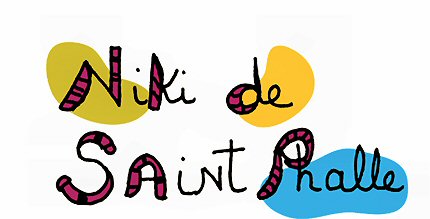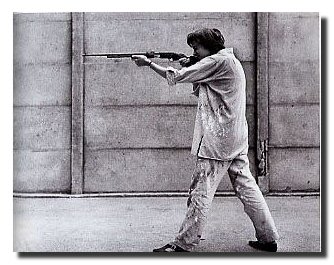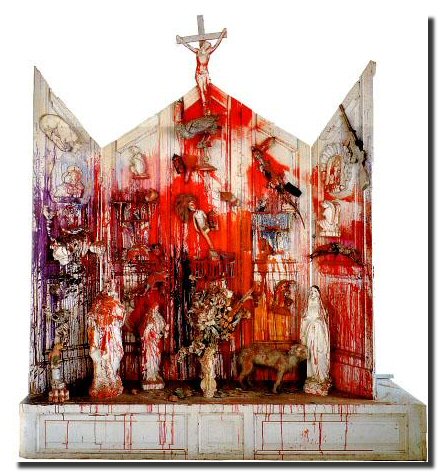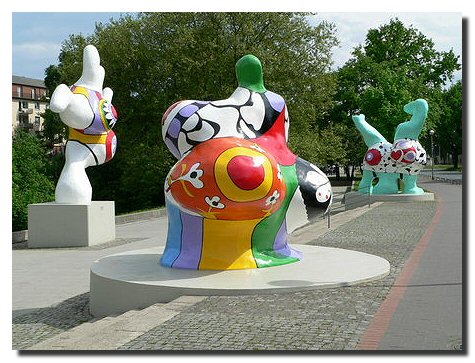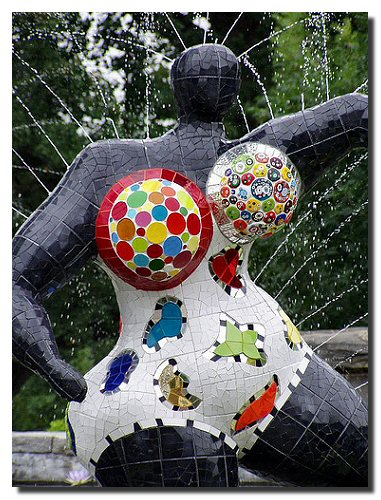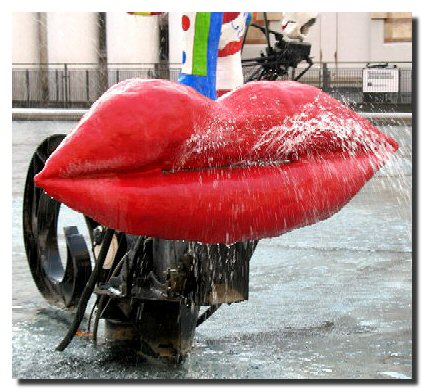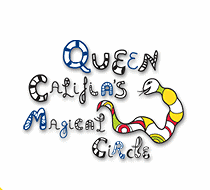|
(1930 - 2002)
WORK Niki de Saint Phalle's work today is internationally acknowledged and accepted. She is one of the most famous artists of the 20th century, and she continues today to be a major figure in contemporary art - vivacious and inventive, original and open-minded.
Shooting Paintings From her early works of the 1950s, when she began drawing and painting, through her assemblages and shooting pictures (a series of works that were created by shooting the reliefs and sculptures with containers of paints buried underneath them.) to the political and artistic statements of the early 1960s, her artistic career developed at a rapid rate.
("I was shooting at myself, society with its injustices. I was shooting at my own violence and the violence of the times.")
(Autel, 1970 - example of a "shooting" painting)
Nanas After the "Shooting paintings" came a period when she explored the various roles of woman. She made life size dolls of women, such as brides and mothers giving birth. They were usually dressed in white. They were primarily made of polyester with a wire framework. They were generally created from papier mâché. Inspired by the pregnancy of her friend Clarice Rivers, the wife of American artist Larry Rivers, she began to use her artwork to consider archetypal female figures in relation to her thinking on the position of women in society. Her artistic expression of the proverbial everywoman were named "Nanas". These large-scale, outrageous and colourful sculptures have appeared in museums, advertisements and worldwide exhibitions.
("At any rate they were a statement of the glory of women. And also there were lots of pregnant women that I did at that point, showing the greatness of motherhood")
Long before she invented her Nanas, the central concepts of her art had already been identified. There were the additive strategies of collage and assemblage (the collection and altering of found materials). Her approach to landscapes, the introduction of narrative figures and stories, and overall an intense relationship between the private life and public work.
The Stravinsky Fountain In 1982, Niki and Jean created the Stravinsky fountain in Paris, located next to the Centre Georges Pompidou and the IRCAM Music Center. 16 mechanical sculptures inspired after Igor Stravinsky's music gyrate and blow water in a distinctly modern piece. (Click on the picture to see the complete fountain)
The Tarot Garden
Influenced by Gaudí's Parc Güell in Barcelona, and the garden in Bomarzo, de Saint Phalle decided that she wanted to make something similar; a monumental sculpture park created by a woman. When Niki de St. Phalle confided her lifelong dream to build a sculpture garden based on the symbols from the Tarot cards to her friend Marella, wife of Fiat (Italian cars) owner Gianni Agnelli, Marella and her brothers gave her a large piece of land where in Garavicchio,near Capalbio in Tuscany, Italy, about 100 km north-west of Rome along the coast, in 1979. The garden, called Giardino dei Tarocchi in Italian, her most ambitious work, contains sculptures of the symbols found on Tarot cards. The garden took many years, and a considerable sum of money, to complete. Jean Tinguely and his All Star Swiss Team took on the task of welding the Tarot sculptures. The garden opened in 1998, after more than 20 years of work.
(Inside the Magician) The Tarot Garden features mirrors, glass and ceramic mosaics. De Saint Phalle had never used these materials before and they show the influence of Antonio Gaudí. This park contains Nana-like figures, serpents, fountains and sculptures you can walk into are often a part of her work. This Garden is almost indescribable; you just have to see it - to walk around in it. Every piece of mosaic on all the sculptures is a work of art in itself. The combinations of colours are multiple and change in mood.
Queen Califia’s Magical Circle
When Niki died in 2002 her granddaughter Bloum
Cardenas*, and members and technical advisors of her grandmother's international staff oversee final work on Escondido
and other unfinished projects to ensure they meet her specifications (Click on the above logo for a short visit to the garden)
*) Bloum Cardenas is the head of "The Niki Charitable Art
Foundation", a non profit organisation committed to the artist
ideals and the preservation of her legacy for future generations.
Sources: Wikipedia, Website Niki de Saint Phalle
|
